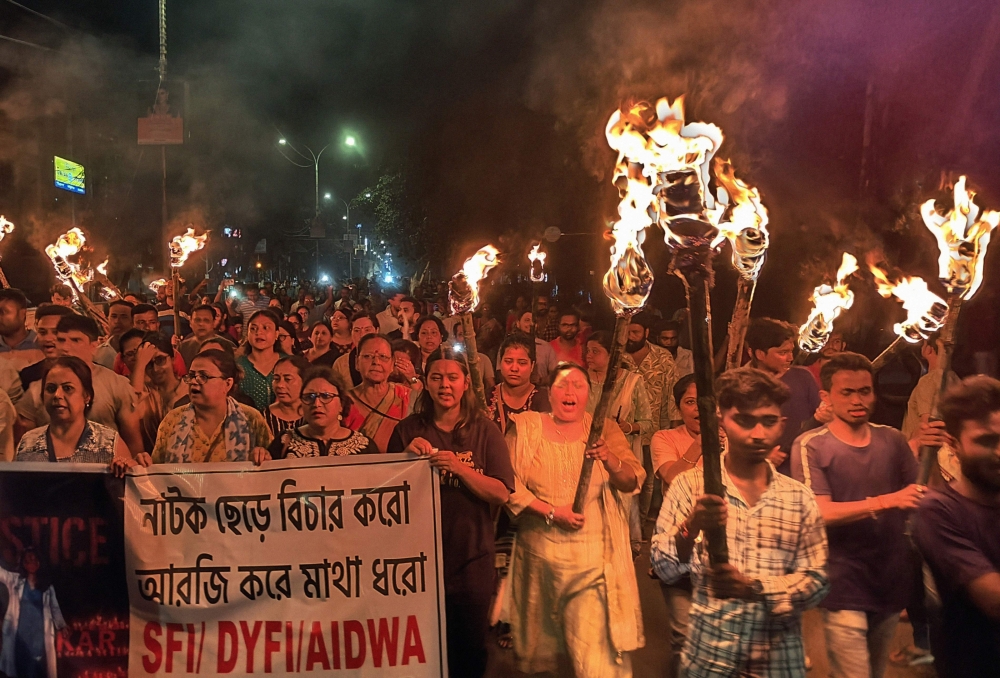
According to the newspaper, the war has claimed the lives of tens of thousands of Palestinians, many of whom were in zones previously designated as “safe” by the Israeli military.
The report criticized Israeli Prime Minister Benjamin Netanyahu for accusing “the international community of hypocrisy concerning the war in the Gaza Strip – and to claim it is ignoring other conflicts and humanitarian disasters.”
For example, Netanyahu in January said: “Where was South Africa when millions were killed or expelled from their homes in Syria and Yemen?”
“But a cold examination of the numbers killed in the Gaza Strip reveals this is one of the bloodiest wars since the beginning of the century, especially if you examine the rate of mortality out of the total population,” the report added.
Haaretz pointed out that the Gaza war has resulted in an extraordinarily high death toll, with approximately 40,000 Palestinians killed since the onslaught began on Oct. 7 last year -- equating to around 2% of Gaza's population of two million.
-Targeting safe areas
Despite the Israeli army's designation of certain areas in Gaza as “safe areas,” the daily said that “most of the residents of Gaza have been displaced, but their escape to areas the Israel Defense Forces (army) has designated as safe zones has not always helped, and many have been killed in these areas too.”
The Israeli forces have repeatedly targeted “safe areas” where displaced civilians gathered, resulting in the deaths of hundreds of people, including women and children.
The report noted that international organizations and media outlets have consistently verified the casualty figures provided by Gaza's Ministry of Health.
As of Wednesday, the ministry reported nearly 40,000 Palestinian deaths and over 92,000 injuries due to the ongoing war, with more than 10,000 people still missing under the rubble.
Haaretz compared the Gaza conflict to other major humanitarian disasters.
“In the Rohingya genocide in Myanmar, for example, about 25,000 people have been killed, according to the United Nations.
“The war in Gaza also stands out in comparison to wars from the 1990s, for example those that took place in the former state of Yugoslavia. One of these regions was Bosnia, and in the worst year of the conflict, 1991, the average number of deaths per month was 2,097 – and the total number killed over four years there was 63,000,” it added.
- 4,000 fatalities per month
The newspaper highlighted the alarming death rate in Gaza, which averages around 4,000 fatalities per month, far surpassing the monthly death toll in Ukraine's ongoing conflict.
One of the most striking aspects of the Gaza war, according to Haaretz, is the lack of safe refuge for civilians. The densely populated, 360-square-kilometer (139-square-mile) area offers little to no escape for non-combatants, further exacerbating the humanitarian crisis.
“The difference that stands out the most between the rest of the wars of the 21st century and the war in the Gaza Strip is the size of the territory where the fighting is taking place, and the inability of the uninvolved civilians to flee the battles – and in particular the percentage of casualties among the overall population,” the newspaper elaborated.
Living conditions for displaced civilians in so-called “humanitarian” zones are dire, with overcrowding, disease and a lack of shelter and medical supplies. Haaretz emphasized the staggering impact of the war, noting that 2% of Gaza's population has been killed in less than a year—a level of destruction rarely seen outside of Africa since World War II.
Michael Spagat, a professor at the University of London who specializes in monitoring conflict casualties, told Haaretz that “in terms of the total number of dead, I assume Gaza won't be among the 10 most violent conflicts of the 21st century.”
"But compared to the percentage of the population killed," Spagat assumes it is already “among the top five.”
The devastation in Gaza has led to widespread starvation and malnutrition, particularly among children. As of Wednesday, 115 infants had died since the start of the war, according to Gaza's Ministry of Health. The ministry also reported that 37 Palestinians, including children, have succumbed to hunger and malnutrition during the conflict.
Adding to the grim toll, Gaza's Civil Defense announced the deaths of two more rescue workers in Rafah on Wednesday, bringing the total number of first responders killed since Oct. 7 to 82.
Israel, flouting a UN Security Council resolution demanding an immediate cease-fire, has faced international condemnation amid its continued brutal offensive on Gaza since an Oct. 7 attack last year by the Palestinian resistance group Hamas.
Nearly 40,000 Palestinians have since been killed in Gaza, most of them women and children, and over 92,000 others injured, according to local health authorities.
More than 10 months into the Israeli war, vast tracts of Gaza lie in ruins amid a crippling blockade of food, clean water and medicine.
The International Court of Justice has accused Israel of genocide and ordered a halt to its military operations in the southern city of Rafah, where over a million Palestinians had sought refuge before the city was invaded on May 6.
Israel’s endgame in Gaza, an impossible mission
August 15, 2024

A person holds a placard that reads ‘The Nakba never ended’ in London during the ‘National March for Gaza’ on August 3, 2024 [CARLOS JASSO/AFP via Getty Images]
Throughout the war on Gaza the weapon of disinformation has been used with lethal effect. From the beginning, Israel’s Western allies led the assault on global public opinion. Untruths about the beheading of babies and rape of Israeli women were repeated and overblown without verification. Other fabrications that continue to gain currency include the claim that Israel does not have an endgame in Gaza. Of course it does.
For Israel’s right-wing government, the ideal endgame is a second Nakba. That requires the depopulation of every town and village in Gaza, and the forced expulsion of survivors to the Egyptian Sinai. Eighty-four per cent of Gaza’s territory is now under evacuation orders.
Calls for the ethnic cleansing of Gaza started long before ‘Operation Al-Aqsa Flood’. In October 2021, Minister of Finance, Bezalel Smotrich, told Arab parliamentarians: “I am not holding any conversations with you, you anti-Zionists…You are [here] due to a mistake because [Israel’s first Prime Minister David] Ben-Gurion didn’t finish the job and throw you out in 1948.”
More recently, in November 2023, Avi Dichter, the incumbent security cabinet member and agriculture minister, announced: “We are now rolling out the Gaza Nakba.”
“Gaza Nakba 2023. That’s how it’ll end,” he stressed.
Everything that has taken place in Gaza since October 2023 confirms that there is indeed a plan. It is to make Gaza unlivable so that its inhabitants would simply pack up and leave. Already, a total of 1.9 million people, or nine in every ten in Gaza have been displaced.
WATCH: Nakba survivor: ‘The current war on Gaza is crueller than the Nakba’
Even so, Israeli Prime Minister Benjamin Netanyahu’s army remains demoralised and substantially weakened. Senior army officers and officials in the intelligence community have been openly criticising the prime minister, saying that the war is unwinnable. Army spokesman Daniel Hagari caused uproar when he told Israel’s Channel 13 in June that “Hamas is an idea, Hamas is a party. It’s rooted in the hearts of the people — anyone who thinks we can eliminate Hamas is wrong.” He added: “To say that we are going to make Hamas disappear is to throw sand in people’s eyes.”
Similarly, former Mossad deputy chief Ram Ben-Barak lamented the fact that Israel is losing the war in Gaza. “This war lacks a clear objective, and it’s evident that we’re unequivocally losing it,” Ben-Barak told Israeli public radio. “We are forced to engage in fighting in the same areas and end up losing more soldiers,” he said.
Faced with this reality of mounting losses of men and equipment, and the refusal of hundreds of reservists to fight in Gaza, the Israeli government has resorted to the supreme court to order the conscription of ultra-Orthodox yeshiva students into the army. They were previously exempt from military service. Whereas some 1,000 were expected to register on 5 August, only 30 actually turned up.

76 years on, Palestinians are still living the Nakba – Cartoon [Sabaaneh/MiddleEastMonitor]Like a desperate and compulsive gambler making the last throw of his dice, Netanyahu has therefore decided to intensify the bombing of Palestinian shelters across Gaza, claiming that a similar campaign was conducted by the Allies during World War Two. According to his twisted logic, the Israeli prime minister reckoned that by killing more civilians this would pressure Hamas to surrender or even force the civilians to rise up against the resistance. What he has failed to acknowledge is that after the destruction of 58 German cities, neither did Hitler capitulate or did the German people rise up against him. Likewise, although the German Blitz of London and other British cities in 1940-41 killed an estimated 40,000 people, that did not force the British people to rise up against Churchill.
As it stands, there is nothing to suggest that Gaza’s civilian population is about to seek refuge in Egypt or rise up against the Hamas-led resistance. Israel’s ruling elite have clearly not learnt the lessons from their 1982 invasion of Lebanon. At the time, their objective was to eradicate fighters from the Palestine Liberation Organisation (PLO) in the country. In the end, they were drawn into a war of attrition that lasted two decades until they were booted out in 2000. All that was achieved is that they created the conditions for a resistance movement, Hezbollah, to emerge with a military capability that none of the Palestinian forces possessed then or now.
Having learnt the hard way from their 2001 invasion of Afghanistan, the Biden administration has tried in vain to deter Netanyahu from a protracted war in Gaza. For the US, what started as an operation to defeat Al-Qaeda eventually turned into an operation of regime change and then state building. Eventually, it spent two decades fighting in Afghanistan and achieved none of its objectives.
Israel’s current war in Gaza bears distinct similarities to its misadventure in Lebanon and the American fiasco in Afghanistan. Gaza has evidently become the quagmire that was predicted. The ‘absolute’ defeat of Hamas that was promised ten months ago is proving to be more distant and difficult than envisaged. Worse still, the preferred option of expulsion and reoccupation also seems unattainable. With or without an endgame, Israel faces a mission impossible in Gaza.




















